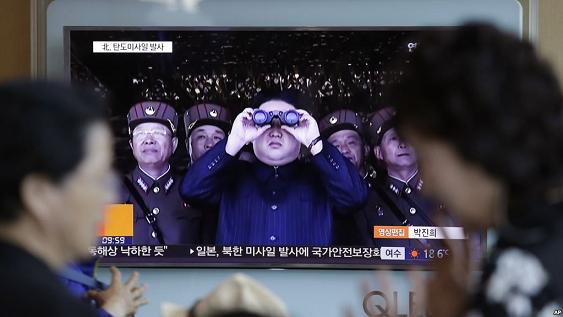by WorldTribune Staff, May 14, 2017
North Korea on May 14 tested a ballistic missile that went further and higher than an intermediate-range missile it tested earlier this year, a report said.
Japanese Defense Minister Tomomi Inada said the missile could be a new type. It flew for 30 minutes before dropping into the sea between North Korea’s east coast and Japan, Reuters reported.

Japanese Prime Minister Shinzo Abe said the North’s missile launches were a “grave threat to our country and a clear violation of U.N. resolutions.”
A U.S. official, speaking on condition of anonymity, said the missile landed 97 kilometers (60 miles) south of Russia’s Vladivostok region.
“With the missile impacting so close to Russian soil – in fact, closer to Russia than to Japan – the president cannot imagine that Russia is pleased,” the White House said, referring to U.S. President Donald Trump.
U.S. Ambassador to the UN Nikki Haley said the launch was not the way for North Korea to earn a meeting with Trump, who has said he would meet North Korean leader Kim Jong-Un under the right circumstances.
On May 13, a top North Korean diplomat said Pyongyang was open to dialogue with the Trump administration under the right conditions.
North Korea is widely believed to be developing a nuclear-capable intercontinental missile that could reach the United States. Trump has vowed not to let that happen.
An intercontinental ballistic missile is considered to have a range of more than 6,000 kilometers (3,700 miles).
Analysts said the missile Pyongyang tested on May 14 was launched at a high trajectory than previous missiles, which would limit the lateral distance it traveled. But if it was fired at a standard trajectory, it would have a range of at least 4,000 kilometers (2,500 miles).
Kim Dong-Yub of Kyungnam University’s Institute of Far Eastern Studies in Seoul said he estimated a standard trajectory would put it in the ICBM range.
“The launch may indeed represent a new missile with a long range,” said Jonathan McDowell of the Harvard Smithsonian Center for Astrophysics, referring to the estimated altitude of more than 2,000 km (1,240 miles). “It is definitely concerning.”
Haley called the launch a message by Pyongyang to South Korea after the election of President Moon Jae-In, who took office on May 10.
“You first have to get into Kim Jong-Un’s head – which is, he’s in a state of paranoia, he’s incredibly concerned about anything and everything around him,” Haley told ABC’s “This Week” program.
Haley added that the United States will “continue to tighten the screws,” referring to sanctions and working with the international community to put pressure on Pyongyang.
South Korea’s Moon held his first National Security Council in response to the launch, which he called a “clear violation” of U.N. Security Council resolutions, his office said.
“The president said while South Korea remains open to the possibility of dialogue with North Korea, it is only possible when the North shows a change in attitude,” Yoon Young-Chan, Moon’s press secretary, told a briefing.
